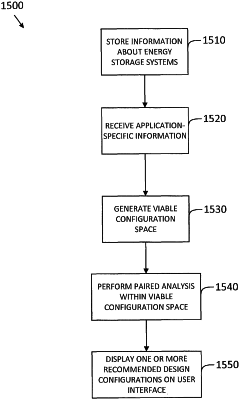| CPC B60L 58/20 (2019.02) [H02J 7/00712 (2020.01); G06F 2119/06 (2020.01); H02J 3/32 (2013.01)] | 18 Claims |

|
1. A computerized system configured to design an electrical storage system using simulation, the computerized system comprising:
at least one computer processor; and
at least one non-transitory computer readable medium encoded with a plurality of instructions that, when executed by the at least one computer processor, perform a method comprising:
generating, based on one or more design requirements and information for a plurality of energy storage systems including a first type of energy storage system and a second type of energy storage system different from the first type of energy storage system, a viable configuration space;
determining, for each of multiple pairs of energy storage systems in the plurality of energy storage systems having characteristics that fall within the viable configuration space, a performance measure of the pair, wherein determining the performance measure comprises evaluating a control strategy that dynamically splits power provided and/or stored by the first and second energy storage systems in the pair during each of a plurality of time intervals by:
determining whether a load coupled to the first and second energy storage systems is providing energy or consuming energy during a current time interval;
in response to determining that the load is consuming energy during the current time interval, determining whether a power requirement of the load in the current time interval is increasing or decreasing from at least one previous time interval; and
in response to determining that the power requirement of the load in the current time interval is increasing, prioritizing discharging the first energy storage system over discharging the second energy storage system in the current time interval; and
providing, on a user interface, an indication of a pair of energy storage systems selected based on the performance measure.
|